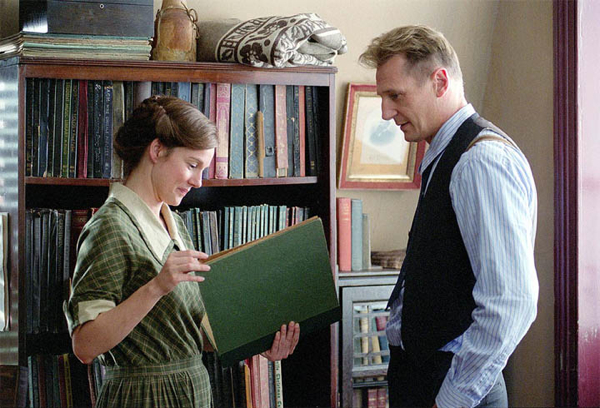Movie review by Greg Carlson
The central irony of sex researcher Alfred Kinsey’s legacy is the argument that even today persists in the so-called “culture wars.” Did the scientist’s work merely illuminate sexual practices that were common but not discussed, or did he encourage a sense of permissiveness that has evolved into a pop culture landscape littered with provocative imagery and barely-concealed libidinous desire? Bill Condon’s excellent movie explores both sides of the issue, and in the process argues for tolerance without stooping to smugness or sermonizing. Condon, whose earlier “Gods and Monsters” imagined the inner life of classic Hollywood director James Whale, does justice to another historical figure, and “Kinsey” is certain to earn many warm accolades.
With his nerdy bow tie and goober crew cut, Kinsey personified the techie-scholar archetype. Fortunately for the movie version, Liam Neeson is on hand (which suddenly makes the neckwear and hairdo a whole lot sexier). Neeson’s performance is simply terrific, and the actor deftly manages the difficult task of playing an academic by infusing his Kinsey with moving nobility, a deep-seated sense of conviction in the value of his work, and stirring charisma. Neeson clearly relishes the role, and Condon provides him with ample opportunities to showcase his formidable talents.
Condon does his best at alleviating the shortcomings of the biopic genre, but like most movies about important people, “Kinsey” focuses on the central points of conflict in the man’s life. We retrace Kinsey’s complex relationship with his father (nicely portrayed by John Lithgow) as well as his early research in zoology. It is the arrival of Clara McMillen (a superb Laura Linney) that allows for Kinsey’s shift in interest away from the gall wasp and toward sexual behavior in humans. When he realizes that he is woefully ill-prepared to interact sexually with his new wife, Kinsey has a career-changing epiphany once a doctor suggests some utilitarian advice to the newlyweds.
The film really takes off once Kinsey decides to collect the narrative sexual histories of anyone willing to speak with him. Enlisting the aid of several research assistants, Kinsey relies primarily on a trio of intriguing young men (Peter Sarsgaard, Chris O’Donnell, and Timothy Hutton) who are trained to collect the data crucial to Kinsey’s understanding of the way people really behave in the bedroom. Sarsgaard’s Clyde Martin emerges as the most intriguing member of the group in part because of the rather unique relationship he develops with Mr. and Mrs. Kinsey. Condon anticipates the comic potential contained within Kinsey’s coterie, and the movie exploits it with adroitness.
Condon presents both Kinsey’s project and its subsequent consequences in such a way as to highlight the intellectual elements of the work as much as the sensational public reaction that followed. The director juggles the intimate drama of Kinsey’s personal life with the broader politics of an era where most sex education courses on college campuses avoided details in favor of prudish obfuscation. Of course, Kinsey’s reports would change many things. In one giddy montage, Condon trots out a “Time” magazine cover, Kinsey’s name-check in “Too Darn Hot,” and the famous cartoon that asks “Is there a Mrs. Kinsey?” That Kinsey was for a time one of the most well-known people in the entire world testifies to the ground-breaking nature of his obsession, and with his movie version, Condon has provided moviegoers with a unique opportunity to study a remarkable person.
